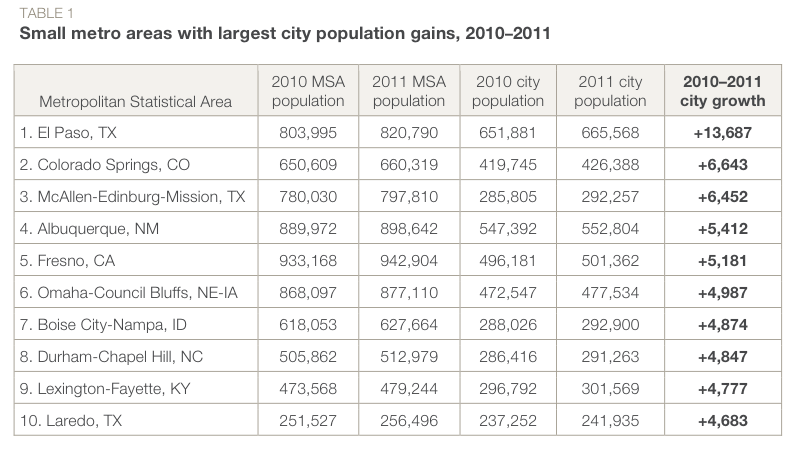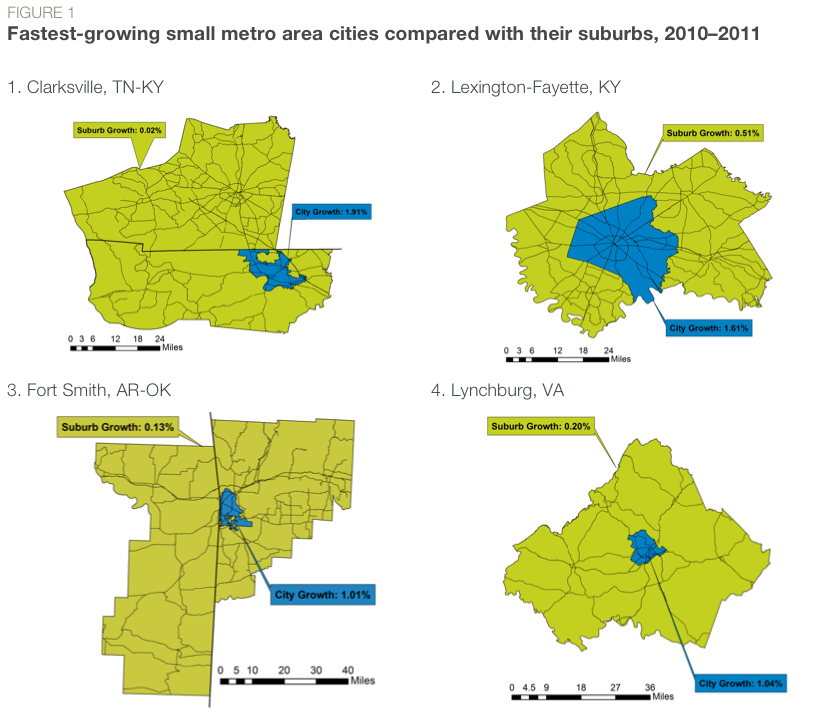SMART GROWTH AMERICA
Summary
Cities are growing faster than their suburbs for the first time in recent history, and this new trend applies to some of the country’s smallest metro areas as well as the biggest.
Earlier this year, the Brookings Institution released new research which revealed cities in the country’s 51 largest metropolitan areas were, on average, growing faster than their suburbs for the first time in decades.
Smart Growth America wondered if this was true in smaller metro areas as well. Following a methodology similar to that used by Brookings, we calculated population growth between 2010 and 2011 in 171 of the nation’s smaller metropolitan areas.
This analysis looked at U.S. Census-designated Metropolitan Statistical Areas (MSAs) with populations between 150,000 and 1 million that also have at least one primary city of at least 50,000 people, based on 2010 Census figures and 2011 Census estimates. These “small metro areas” are the focus of our examination.
Overall, 22% of the U.S. population lives in small metro areas – more than 69 million people. Of these, 39.7%, or 27 million people, lived in cities in 2011. Between 2010 and 2011 small metro area cities grew in population by 0.89%, whereas their suburban counterparts grew by 0.67%. These growth rates may seem trivial, but in small towns and cities they can make a big difference.
Our findings reveal that some of the biggest population gains were made in the smallest metro areas. Our analysis examined absolute increase in population, the rate of growth, and how small metro areas compared to large ones. We found that not only are small metro areas part of the larger national trend, many are leading the way.
At the end of this report we discuss why this might be happening. We take a brief look at 5 of the 171 cities included in this study, and examine the new projects, policies and initiatives that could be contributing to these new population gains.
Methodology
“City” and its boundaries are defined by the U.S. Census Bureau. One primary city and up to two additional cities were used to calculate the “city” population of each MSA; the suburban population was found by subtracting the city population from the total population of the MSA. Population data for cities smaller than 50,000 was not available from the Census for 2011. The Census Bureau’s methodology for allocating the population change between cities and suburbs from 2010 to 2011 within metropolitan areas is based on past trends.
Findings
The research revealed four clear trends about small metro areas: (1) city populations grew from 2010 to 2011; (2) city populations grew at a faster rate than their suburbs; (3) the smaller the metro area, the greater the city population growth; and (4) small metro areas in the Heartland grew fastest.
1. In small metro areas, city populations grew from 2010 to 2011.
Between 2010 and 2011, population increased in 86.5% of cities in small metro areas.2 El Paso, Texas saw the largest growth in city population, gaining a total of 13,687 residents (see Table 1).
These numbers are good news for these cities. In at least some cases, population gains may be a result of new economic opportunities and civic efforts to attract and retain new residents.
The metro areas with the highest city population gains were also among the biggest (with populations between 750,000 and 1 million people). Overall, however, the smallest metro areas (150,000–250,000 people) had the largest number of cities gain population (see Table 2).
2. In small metros areas, city populations grew at a faster rate than their suburbs.
Between 2010 and 2011 small metro area cities grew, in total by 0.89%, whereas their suburban counterparts grew in total by only 0.67%. Table 3 shows the top ten small metros where cities added population at a greater rate than their suburbs.
The maps in Figure 1 show the areas these growth rates represent.
Read full report (PDF) here: City Versus Suburban Growth In Small Metro Areas
About Smart Growth America
www.smartgrowthamerica.org
“Smart Growth America advocates for people who want to live and work in great neighborhoods. We believe smart growth solutions support businesses and jobs, provide more options for how people get around and make it more affordable to live near work and the grocery store. Our coalition works with communities to fight sprawl and save money. We are making America’s neighborhoods great together.”
Tags: cities, Population Increase, Smart Growth America, Suburbs








 RSS Feed
RSS Feed